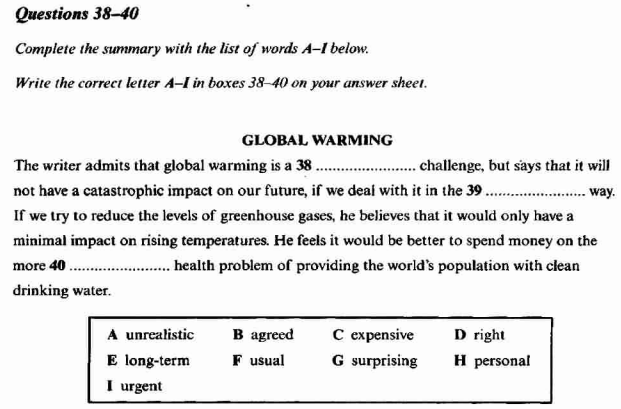剑桥雅思5:Test1雅思阅读PASSAGE 3真题+答案+解析
发布时间:2020-09-14 关键词:剑桥雅思5:Test1雅思阅读PASSAGE 3真题+答案+解析READING PASSAGE 3 剑桥雅思5:Test1雅思阅读PASSAGE 3真题及答案解析
You should spend about 20 minutes on Questions 27- 40, which are based on Reading Passage 3below.
The Truth about the Environment
For many environmentalists, the world seems to be getting worse. They have developeda hit-list of our main fears: that natural resources are running out; that the population isever growing, leaving less and less to eat; that species are becoming extinct in vast
numbers, and that the planet's air and water are becoming ever more polluted.
But a quick look at the facts shows a different picture, First, energy and other naturalresources have become more abundant, not less so, since the book 'The Limits to
Growth' was published in 1972 by a group of scientists. Second, more food is now
produced per head of the world's population than at any time in history. Fewer peopleare starving. Third, although species are indeed becoming extinct, only about 0.7% ofthem are expected to disappear in the next 50 years, not 25-50%, as has so often beenpredicted. And finally, most forms of environmental poliution either appear to have
been exaggerated, or are transient- associated with the early phases of industrialisationand therefore best cured not by restricting economic growth, but by accelerating it. Oneform of pollution - the release of greenhouse gases that causes global warming - doesappear to be a phenomenon that is going to extend well into our future, but its totalimpact is unlikely to pose a devastating problem. A bigger problem may well turn out tobe an inappropriate response to it.
Yet opinion pols suggest that many people nurture the belief that environmental
standards are declining and four factors seem to cause this disjunction between
perception and reality.
One is the lopsidedness built into scientific research. Scientific funding goes mainly toareas with many problems. That may be wise policy, but it will also create an impressionthat many more potential problems exist than is the case.
Secondly, environmental groups need to be noticed by the mass media. They also needto keep the money rolling in, Understandably, perhaps, they sometimes overstate theirarguments. In 1997, for example, the World Wide Fund for Nature issued a press
release entitled: 'Two thirds of the world's forests lost forever'. The truth turns out tobe nearer 20%.
Though these groups are run overwhelmingly by selfless folk, they nevertheless sharemany of the characteristics of other lobby groups. That would matter less if peopleapplied the same degree of scepticism to environmental lobbying as they do to lobbygroups in other fields. A trade organisation arguing for, say, weaker pollution controls isinstantly seen as self-interested. Yet a green organisation opposing such a weakening is seen as altruistic, even if an impartial view of the controls in question might suggestthey are doing more harm than good.
A third source of confusion is the attitude of the media. People are clearly more curiousabout bad news than good. Newspapers and broadcasters are there to provide what thepublic wants. That, however, can lead to significant distortions of perception. An
example was America's encounter with El Niño in 1997 and 1998. This dimatic
phenomenon was accused of wrecking tourism, causing allergies, melting the ski-slopesand causing 22 deaths. However, according to an article in the Bulletin of the AmericanMeteorological Society, the damage it did was estimated at US$4 billion but the benefitsamounted to some USS 19 billion. These came from higher winter temperatures (whichsaved an estimated 850 lives, reduced heating costs and diminished spring floods causedby meltwaters).
The fourth factor is poor individual perception. People worry that the endless rise in theamount of stuff everyone throws away will cause the world to run out of places to
dispose of waste. Yet, even if America's trash output continues to rise as it has done inthe past, and even if the American population doubles by 2100, all the rubbish Americaproduces through the entire 21st century will still take up only one 12,000th of the areaof the entire United States.
So what of global warming? As we know, carbon dioxide emissions are causing theplanet to warm. The best estimates are that the temperatures will rise by 2-3C in thiscentury, causing considerable problems, at a total cost of US$5,000 billion.
Despite the intuition that something drastic needs to be done about such a costlyproblem, economic analyses clearly show it will be far more expensive to cut carbondioxide emissions radically than to pay the costs of adaptation to the increased
temperatures. A model by one of the main authors of the United Nations Climate
Change Panel shows how an expected temperature increase of 2.1 degrees in 2100would only be diminished to an increase of 1.9 degrees. Or to put it another way, thetemperature increase that the planet would have experienced in 2094 would be
postponed to 2100.
So this does not prevent global warming, but merely buys the world six years. Yet thecost of reducing carbon dioxide emissions, for the United States alone, will be higherthan the cost of solving the world's single, most pressing health problem: providinguniversal access to clean drinking water and sanitation. Such measures would avoid
2 million deaths every year, and prevent half a billion people from becoming seriously ill.It is crucial that we look at the facts if we want to make the best possible decisions forthe future. It may be costly to be overly optimistic - but more costly still to be too essimistic.
关于环境的真理
对许多环保主义者来说,世界似乎正在变得越来越糟。他们发展出了我们的主要恐惧清单:自然资源正在枯竭;人口在不断增长,留下越来越少的食物可吃;物种正在大量灭绝。
数字,以及地球的空气和水正变得越来越污染。
但是地看一看事实就会发现,首先,能源和其他自然资源变得更加丰富,而不是减少,因为这本书是“限制”。
“成长”是由一组科学家于1972年出版的。第二,现在有的食物。
世界人口的人均产量比历史上任何时候都要高。挨饿的人越来越少。第三,尽管物种确实正在灭绝,但预计只有0.7%的物种会在未来50年消失,而不是人们经常预测的25-50%。最后,大多数形式的环境政治
被夸大了,或者是暂时的--与工业化的早期阶段相关,因此不是通过限制经济增长,而是通过加速经济增长来治愈。一种形式的污染--释放导致全球变暖的温室气体--似乎是一种将延伸到我们未来的现象,但它的总体影响不太可能造成毁灭性的问题。更大的问题很可能是对此的不适当反应。
然而民意调查表明,许多人培养了这样一种信念:
标准在下降,四个因素似乎导致了感知和现实。
一是科学研究的片面性。科学经费主要用于有许多问题的领域。这可能是明智的政策,但也会造成一种印象,即存在比实际情况的潜在问题。
第二,环保团体需要大众传媒的关注。他们还需要让资金源源不断地流入,这是可以理解的,也许,他们有时夸大了自己的论点。例如,1997年,世界自然基金会发布了一份新闻
题为:“世界上三分之二的森林永远消失”的新闻稿。事实证明,真相接近20%。
虽然这些团体绝大多数是由无私的人管理的,但他们也有许多其他游说团体的特点。如果人们像对待其他领域的游说团体一样,对环境游说采取同样程度的怀疑态度,那就不那么重要了。一个贸易组织,比如说,主张更弱的污染控制的组织,立刻被认为是利己主义者。然而,一个反对这种削弱的绿色组织是被认为是利他主义的,即使对有关控制的公正看法可能意味着他们所做的是弊大于利。
造成混乱的第三个原因是媒体的态度。人们对坏消息显然比对奇。报纸和广播公司在那里提供公众想要的东西。然而,这可能导致观念的重大扭曲。阿
1997年和1998年美国遭遇厄尔尼诺现象就是一个例子。这种双色
有人指责现象破坏了旅游业,引起过敏,融化了滑雪坡,造成22人死亡。然而,根据“美国气象学会公报”的一篇文章,它所造成的损失估计为40亿美元,但其收益约为190亿美元。这些都来自更高的冬季温度(据估计,这挽救了850人的生命,降低了取暖成本,并减少了由融雪引起的春季洪水)。
第四个因素是个体感知能力差。人们担心,每一个人扔掉的东西数量的无止境的增加会导致世界上没有地方去。
处理废物。然而,即使美国的垃圾产量继续像过去那样增长,即使到2100年美国人口翻了一番,整个21世纪美国产生的垃圾仍然只占整个美国面积的12000%。
那么全球变暖又如何呢?正如我们所知,二氧化碳的排放导致地球变暖。的估计是,本世纪气温将上升2-3C,造成相当大的问题,总费用为5000亿美元。
尽管直觉认为需要对这样一个成本问题做一些极端的事情,但经济分析清楚地表明,从根本上减少二氧化碳排放比支付适应增加的成本要昂贵得多。
温度。“联合国气候”的主要作者之一的模型“变化面板”显示,2100年的预期气温上升2.1度只会减少到1.9度。换句话说,地球在2094年将会经历的温度升高推迟到2100年。
因此,这并不能阻止全球变暖,而只是为世界买了六年。然而,仅就美国而言,减少二氧化碳排放的成本将高于解决世界上、最紧迫的健康问题的成本:普及清洁饮用水和卫生设施。这些措施将避免
每年有200万人死亡,防止5亿人患上重病,如果我们想要为未来做出的决定,就必须正视事实。过于乐观可能代价高昂,但过于乐观仍然代价更大。悲观。



剑桥雅思5:Test1雅思阅读PASSAGE 3答案解析





